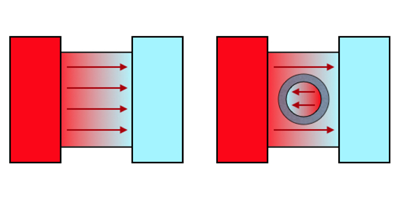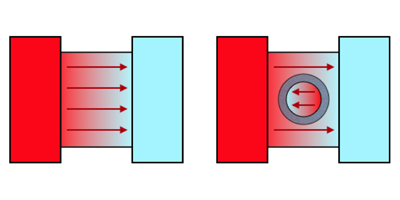Layering to Warm Up
Thermal current devices, unlike electronic or photonic ones, aren’t yet in widespread use, largely because it is difficult to control heat flow. In a paper in Physical Review Letters, Supradeep Narayana and Yuki Sato of Harvard University introduce a device composed of engineered artificial materials that allows considerable control over conduction and other properties of heat.
The authors first study a thin cylindrical shell of copper embedded in a gel block through which heat flows; the high thermal conductivity of the cylinder routes heat around its center. Next they investigate a hollow cylinder of polyurethane, but its conductivity is not quite low enough to isolate the core. Finally, they fabricate a cylinder with alternating layers of -mm-thick natural latex rubber and -mm-thick silicone elastomer. Despite the insulating behavior of the component materials, the anisotropy of the composite forces the heat to flow around the core so that the heat shielding is no worse than with copper, while the outside temperature gradient is less distorted than with either the copper or polyurethane cylinders.
Through a series of measurements, the authors show that this layered cylinder of inherently isotropic materials functions as an anisotropic device that offers great control over shielding, concentration, and inversion of heat currents. Their expectation is that this novel, made-to-order prototype will lead the way to precise control over heat flux in realistic thermal devices. – Sami Mitra





